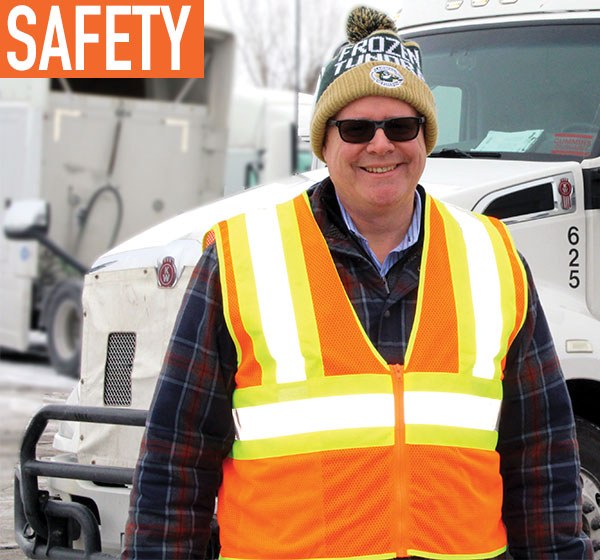If you have the intestinal fortitude to self-insure, you better be sure you have a safe fleet—one filled with checks and balances to ensure a safe operation. For Contract Transport Services (CTS), the answer is “We do.”
CTS, which is based out of Green Bay, Wisconsin, operates a fleet of more than 130 trucks—nearly all day cabs. Delivering primarily paper and packaging supplies throughout the Midwest, its trucks are stationed at multiple locations in order to be close to customers. CTS has an impressive 7 to 1 trailer to truck ratio, which gives more drop-and-hook and quick turnaround advantages to its customers and drivers. While delivering on time is a key metric for CTS, so is being good to the environment. Half the company’s fleet of Kenworths and Freightliners are CNG powered with plans to be 100% CNG by the end of 2019.
According to Paul LeRoy, CTS’ director of safety for the past 15 years, the company’s success is all for naught if it doesn’t have safety in mind from the get-go. “It’s our culture and who we are,” he says. “Everything begins and ends with safety for our drivers and for others on the roadway. Chargeable accidents against the company are very few and far between.”
SAFETY TAKES WORK
On average, the company runs 13 million miles a year—typically each truck runs 400 to 500 miles a day in dedicated and regional operations. Its trucks are equipped with collision mitigation systems—the Bendix Wingman system on its Kenworths and Wabco’s OnGuard system on its Freightliners. It also uses DriveCam by Lytx. In 2017, CTS had four reportable accidents for a DOT rate of just 0.30 DOT; in 2016, the company had just three reportable accidents with virtually the same mileage. Anything under 0.50 DOT is considered very well.
According to LeRoy, safety takes work. At CTS it begins with three weeks of one-on-one training for new drivers from a driver training school, and it’s augmented with online driver training through CarriersEdge. CTS also has consistent safety and training reinforcement through the company’s “state of the union” meetings and encourages its drivers to participate in state driving championships.
“When we hire entry-level drivers that completed a driver training school, we match them with a ‘mentor/trainer’ and start them off making local deliveries the first week to help sharpen their backing skills,” LeRoy says. “The second week we target larger city driving and the third week we look to get them into Chicago. After our mentor/trainer approves them to be on their own, they are given a final road test by our training manager. Upon passing, they’re on the road but not forgotten. We do another drive along with them after three months to ensure they have not developed any bad habits or are taking short cuts. We typically have about 35 to 40 entry-level drivers per year that go through this program.”
VIRTUAL TRAINING
Supporting drivers further is done through online training.
“Online training works well for us,” LeRoy says. “Before online training we were doing four live training sessions each year with our drivers. But that was very difficult. Our drivers start anywhere from 2 am to 10 am. So, we would do 30-minute sessions starting at 3 am and had that going every half hour until 5 pm. With rotating drivers, it actually gave us only about 20 minutes of real time with drivers and the amount of information we could pass along wasn’t sufficient. Time constraints really hampered what we could do.”

CTS started working with CarriersEdge in 2015 after moving away from a video-based online training program. “Ease of use, cost, and the quality of the material presented in the modules were what drove us to work with CarriersEdge,” LeRoy explains. “Online training is so much more convenient for our drivers and our training staff. Drivers can go through the training modules when it’s convenient for them—either at home, in their cab during a break, or at one of our terminals where we have computers set up for their use.”
While online training helps drivers go through the modules when drivers are ready to learn, the biggest benefit is the retention of information and key facts. “That’s ultimately what we want,” LeRoy says. “The way the instruction modules from CarriersEdge are set up help drivers get engaged and retain the information presented. We want our drivers to have a ‘take away’—they gain a nugget or two of new information during each session. We can also monitor how our drivers have done on each module. If there is an area they didn’t score well on, we can review the test with them and help them with additional information.”
CUSTOM TRAINING
CTS has a quarterly training module augmented with custom training modules developed by CTS. “I’ll go through each CarriersEdge module myself to see what our drivers will learn and the questions that will be asked,” he says. “So far this year we’ve gone through winter driving, defensive driving, and food safety modules. Our custom modules have included training on other topics specific to CTS, plus a module on CNG and refueling. Our semi-annual state of the union address and ‘live training’ broadcasts are also uploaded on the CarriersEdge site so drivers can see this information in real time or go back to it when they have free time. The uploading capability with CarriersEdge makes things easy for us. All our safety information is contained within the program.”

To reward and incentivize drivers, CTS has a “performance pay” program with six different areas of concentration including safety and training. According to LeRoy, nearly all the drivers are active participants—it’s in the high 80% range.
What’s more, the company involves drivers to help make the work environment better and more productive. “We continually come up with new ideas to communicate with drivers. Last year we had a program called Driver2Driver,” LeRoy says. “This was a tip or best practice that was shared via digital screens at all locations for other drivers to view. As a new tip came up, the screen changed to reflect the information.”
SAFE ENVIRONMENT
All these programs are working, LeRoy says. “We have a great group of drivers at a company where safety and inclusion is top of mind. We involve everyone through our annual company picnic, plus we sponsor a local race car and gave tickets away to race events. And we have a Driver Appreciation Zone that is a mobile party zone. We take it to all our facilities at least once a year for a cookout to show our appreciation.”
Through its dedication to safety, CTS—with the help of CarriersEdge—is able to deliver an inclusive, safe work environment for its employees and drivers. What’s more important in a work environment?
FOR MORE INFORMATION
Contract Transport Services employs a fleet of more than 150 trucks, providing transportation services in Wisconsin, Minnesota, Illinois, Iowa, and Michigan. Find out more, visit www.ctsgb.com. CarriersEdge is a provider of online driver training. CarriersEdge helps fleets train drivers without sacrificing miles or requiring people to come in on weekends. Find out more about CarriersEdge, visit www.carriersedge.com.
MODERN WORKTRUCK SOLUTIONS: MARCH 2019 ISSUE
Did you enjoy this article?
Subscribe to the FREE Digital Edition of Modern WorkTruck Solutions magazine.





